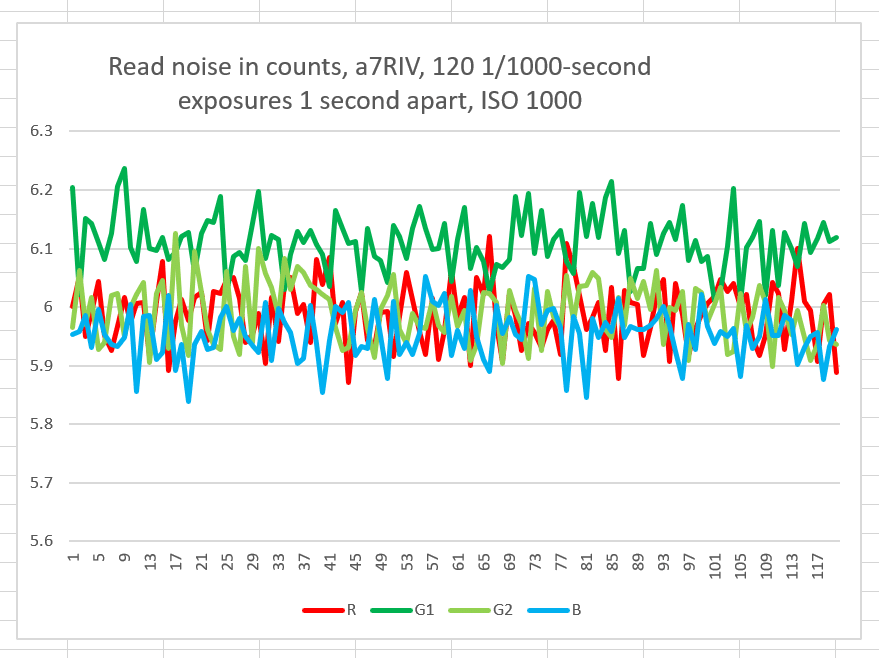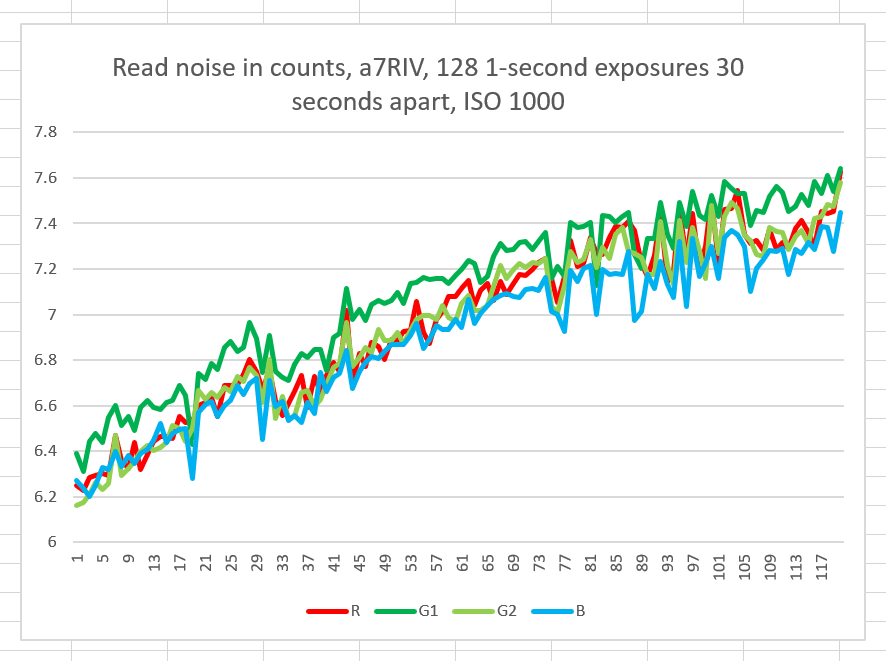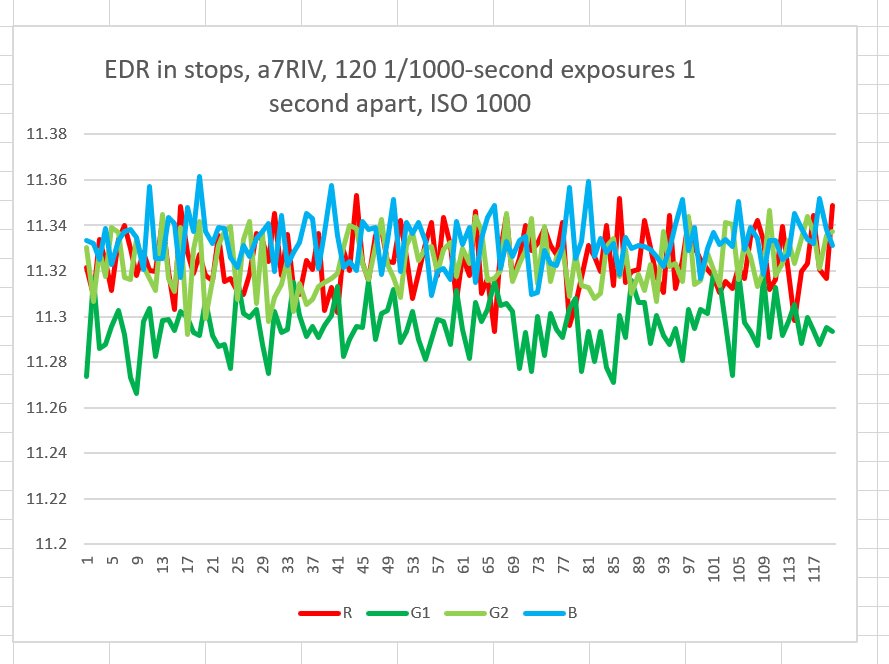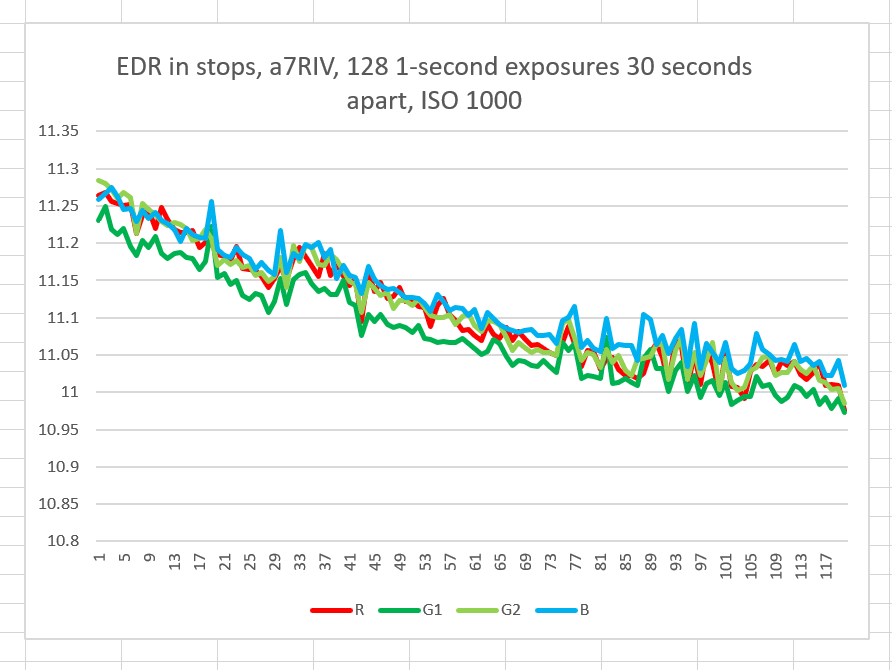This is one in a series of posts on the Sony alpha 7 R Mark IV (aka a7RIV). You should be able to find all the posts about that camera in the Category List on the right sidebar, below the Articles widget. There’s a drop-down menu there that you can use to get to all the posts in this series; just look for “A7RIV”.
The temperature of the sensor has an effect on read noise. This effect is greater for longer exposures. I ran some tests on the Sony a7RIV to quantify it. Both tests used about 128 dark-field exposures. The first was aimed at discovering short-term effects that applied to short exposures. I measured the rms noise in a 600×600 pixel patch just to the left of the center column for each of the raw channels:
There aren’t any short term effects visible.
Then I made a sequence of 128 1-second exposures 30 seconds apart, with the LCD on the whole time, giving the camera more than an hour to warm up:
Here are the two curves expressed in terms of engineering dynamic range (EDR):
Overall, there is about a 0.2 stop change in EDR. That’s not enough to worry about.




Sensor heating caused by photodiode current is tiny compared to sensor heating caused by all the other circuitry. For the GFX 100 you calculated >200mW. So, self heating is worst when the sensor is the most active, like in Live View or video mode. Was the camera in stand-by mode (not active) in between the shots? If so, then self heating would be minimal.
No.
I did nothing of the kind.
You can calculate the photodiode current approximately: take the FWC, multiply it by the number of pixels, multiply by 1.602 * 10^−19, and divide by the exposure time.
For the GFX 100 and 1/100th second scan time, which is very fast, that’s 1.02E8 * 47000 * 1.602E-19 * 100, or 7.6800e-05 amps. With a 5w power supply, which is probably high, that’s 3.8400e-04 watts, or about a third of a mw.
I intended to say that you previously calculated the photo diode power dissipation for the GFX 100 to be >200mW.
Something very weird is going on with your comments program. My 12:32 pm comments are not what I wrote. Words got deleted.
I did not calculate a number anywhere near that high.
I’ll try one more time. Please note that in 2 previous replies words got droppen. What I wanted to say is that in the past you calculated >200mW.
That’s not what I just typed!!! Your calc was >200mW.
Again words are dropped. Are you paying any attention?
Last try!
Your photo diode calc was >200mW.
Let’s see if more words are lost.
It was not. It was a few hundred microwatts under some pessimistic assumptions.
What words were dropped?
I didn’t.
Your comments machine is totally our of whack and drops many words or you are playing games.
No one else has complained.
If you can’t make my blog work to your satisfaction, post your questions on DPRs Sony alpha full frame forum, and I’ll deal with it there.
On August 22 you emailed me and estimated <= 1uA at 5V or <=5uW.
On August 23 you corrected that to <100nA or <0.5uW.
My estimate of total power 200mW or more.
If I said that, under one set of assumptions, total current was less than 1 ua, and power less than 5 uW, then said it’s probably even lower, how do you figure I said total power was more than 200 milliwatt? Makes no sense to me.
The >>200mW is my guestimate of total sensor power dissipation based on the fact that Sony sensor data sheets lowest value for power dissipation is 160mW for a 5MP sensor. Therefore, the lions share of sensor heating is caused by total sensor power dissipation, not photo diode current.
I certainly agree that the lions share of sensor heating is caused by total sensor power dissipation, not photo diode current.